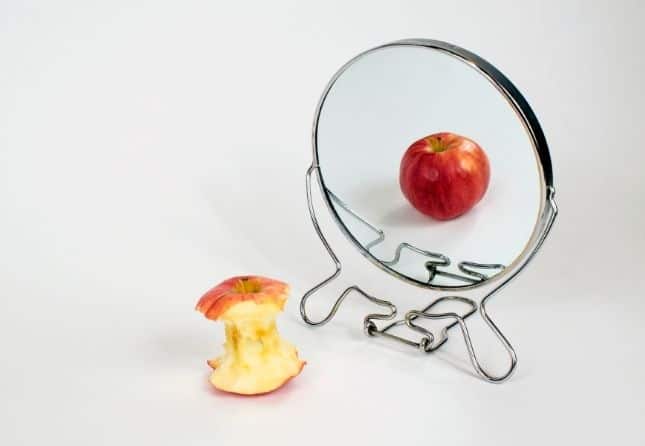Home > Emotional wellbeing > Mental health > Let’s talk body image and body dysmorphia: Part 1


What do you see when you look in the mirror darlings? In an ideal world, we’d say we see a beauty, a true reflection of ourselves. However, we don’t live in an ideal world. We live in a world where fashion magazines and so-called influencers dictate what is considered to pass a beauty these days. So would it surprise you to discover that in a 2018 poll by IPSOS, 79% of Americans sometimes felt unhappy with their body image?
When we’re fed a diet of “this is what you should aspire to look like” images on social media, in magazines and in the movies, it’s very easy to get hooked into thinking that if you don’t look that way, you are less worthy of being liked or loved.
Hands up if this sounds like you?
And when we feel less worthy, what do we notice when we look in the mirror? Yes, that’s right, we see and focus on all the lumps and bumps!
I know I do. Even when I was a size zero (believe it or not, I was), all I could see was fatness and ugliness when I looked in the mirror.
Negative body image is the term used when we look in the mirror and are unhappy with what we see. Whether or not that view is warranted or not.
And let’s face it, many of us will have days when we feel unhappy at what we see in the mirror. Especially if it’s the morning after a night out which has involved a large meal and much alcohol.
However, when you become obsessed with any perceived flaws you think you see in your reflection, you could be in danger of developing body dysmorphic disorder (BDD).
BDD is classified as an obsessive-compulsive disorder. This is because you don’t just notice the lumps and bumps, you become fixated on certain areas that you feel are imperfect. In many cases, the ‘imperfection’ is not even noticeable to anyone else.
However, this fixation will morph into occupying every waking thought as you try everything and anything to ‘fix’ the imperfection.
These include; wearing clothing to hide or disguise certain body areas or features, constantly checking your reflection in the mirror or comparing yourself to someone else, skin picking, excessive grooming and even looking into cosmetic surgery.
These behaviours will be repeated many times each and every day, and you could feel very distressed, to the extent that this obsession with your perceived flaws begins to affects your life including, your social and work life.
Having an unhealthy body image is normally associated with eating disorders. However, although there are some similarities between them, not everyone with an eating disorder has BDD. This is because BDD is not related to weight but body features that would not be altered through excessive weight loss.
There is, however, an overlap between people suffering from anxiety-related disorders and BDD. This is because the pressure of trying to fix these supposed flaws can make sufferers feel anxious about social interactions and also lead to depression.
The best thing to do if you think your BDD is taking over your life is to visit your doctor. However, there are some coping strategies you can use:
This is tricky, especially for those with BDD. But if you can, try and avoid the things that send your comparison button into overdrive, such as social media, magazines, etc.
When you aren’t constantly comparing yourself to others, it may become easier to accept yourself as who you are.
This is a toughie, especially when you are convinced you have flaws that make you unworthy. However, it is possible to break the cycle with help.
In Psychology, there’s something called the Thoughts, Feelings and Behaviour Cycle, and it’s this that we need to change.
It is, however, slightly more complex than simply ‘changing your self-talk’ from negative to positive. You need to delve into the triggers, and once you have found them you can work on coping strategies to help improve your thoughts, which ultimately improve how you feel and what you do.
At the end of the day, we are all human, we are all unique and we all have our good bits and bad bits. We need to learn to filter out the fakeness from social media and the mainstream media and concentrate on how amazing we really are.
It is by accentuating the positives about us that we realise those perceived ‘bad’ bit aren’t really that awful at all.
Until next time darlings.
xx
Disclaimer: This website does not provide medical advice
The information, including but not limited to, text, graphics, images and other material contained on this website are for informational purposes only. No material on this site is intended to be a substitute for professional medical advice, diagnosis or treatment. Always seek the advice of your physician or other qualified health care provider with any questions you may have regarding a medical condition or treatment and before undertaking a new health care regimen, and never disregard professional medical advice or delay in seeking it because of something you have read on this website.

-


Dr Singh is the Medical Director of the Indiana Sleep Center. His research and clinical practice focuses on the myriad of sleep.

What does spotting before your period look like? Spotting is a few drops of blood on your underwear that are not enough to soak a pad. It’s typically brown, light pink, or red and may only be noticeable on a

Postpartum hormonal changes: What are they? Postpartum hormonal changes occur when your body experiences shifting hormone levels after birth. After your baby is born, the doctor removes the afterbirth or placenta, which sends signals to your body that you’re no

What is ovulation fatigue? As women, we can get numerous symptoms throughout our menstrual cycles. One question we’re asked is, “Why do you get tired during ovulation?” For some, the answer could be ovulation fatigue. Ovulation fatigue is when you
Hormona© 2025, All Rights Reserved
| Cookie | Duration | Description |
|---|---|---|
| cookielawinfo-checkbox-analytics | 11 months | This cookie is set by GDPR Cookie Consent plugin. The cookie is used to store the user consent for the cookies in the category "Analytics". |
| cookielawinfo-checkbox-functional | 11 months | The cookie is set by GDPR cookie consent to record the user consent for the cookies in the category "Functional". |
| cookielawinfo-checkbox-necessary | 11 months | This cookie is set by GDPR Cookie Consent plugin. The cookies is used to store the user consent for the cookies in the category "Necessary". |
| cookielawinfo-checkbox-others | 11 months | This cookie is set by GDPR Cookie Consent plugin. The cookie is used to store the user consent for the cookies in the category "Other. |
| cookielawinfo-checkbox-performance | 11 months | This cookie is set by GDPR Cookie Consent plugin. The cookie is used to store the user consent for the cookies in the category "Performance". |
| viewed_cookie_policy | 11 months | The cookie is set by the GDPR Cookie Consent plugin and is used to store whether or not user has consented to the use of cookies. It does not store any personal data. |
